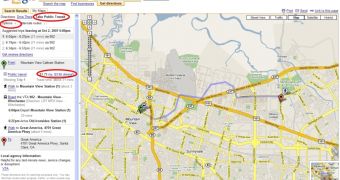Google Transit updated Google Maps again as the web-based mapping tool is now able to provide public transportation routes for the areas which are already covered by this product. In fact, the entire update comes from Google Transit, the service which was released by Google in 2005 and was supposed to offer transportation options and several details such as the route, the costs of the trip and the entire transit time. Since the official release date, Transit has been updated every once in a while but it never left the Labs. In case you didn't hear about it, Google Labs is a testing platform powered by the super giant that tests all the technologies before they are released as final solutions.
Today, not only that Transit graduated from Labs but it was also included in Google Maps, the mapping technology which is now able to show public transportation routed in a matter of seconds. All you need to do is to search for two areas using Google Maps and, if Transit has coverage, you should see a button named "Take Public Transit". Pressing it will show you other transportation options and several details as mentioned above. Google plans to add more coverage in the next months so let's hope we're among the lucky ones to use Transit.
Moreover, the stand-alone version of Google Transit is still available and you can use it separately from Google Maps by accessing its official page.
"If you're already an old hand at using Google Transit, don't worry. The main Google Transit page, will still be in place. You can use that page to see which transit agencies are currently within our coverage areas. In the past few weeks alone, we've added Bay Area Rapid Transit (San Francisco Bay Area), Santa Clara (CA) Valley Transportation Authority, and Hampton Roads (VA) Transit - among many others. (If you're going to Japan or China, we've got you covered! )," Christoph Oehler, Product Manager, wrote today. "We're still working hard to make Google Transit useful for as many people as possible, and we'll keep you posted as we add new regions."

 14 DAY TRIAL //
14 DAY TRIAL //